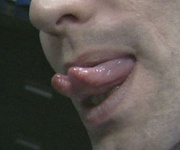Tuhuna and Tunge Forlengelese FAQ: Difference between pages
(Page conversion via llm-mediawiki-rev -jwm) |
(Page conversion via llm-mediawiki-rev -jwm) |
||
| Line 1: | Line 1: | ||
[[File: | [[File:TongueSplitting.jpg|thumb|right|180px]] | ||
''' | The '''[[Tongue|tongue]] splitting''' procedure is the central [[Bifurcation|bifurcation]] of the tongue, so as to achieve a "forked tongue." With practice, each half can be separately controlled. | ||
== Contents == | |||
# [[Placement]] | |||
# [[Procedure]] | |||
## [[#Oral surgery|Oral surgery]] | |||
## [[#Tie-off|Tie-off]] | |||
## [[#Scalpelling|Scalpelling]] | |||
## [[#Cauterizing|Cauterizing]] | |||
## [[#Suturing|Suturing]] | |||
## [[#Risks|Risks]] | |||
# [[Healing and aftercare]] | |||
# [[Long-term health issues]] | |||
# [[History]] | |||
# [[Reversal]] | |||
# [[Legality]] | |||
# [[Related risks]] | |||
# [[External links]] | |||
== Placement == | |||
The median fibrous septum that centrally divides the tongue is cut, separating the two lateral halves of the tongue. Done carefully, very little damage should be done in the process. | |||
== Procedure == | |||
Tongue splitting can be accomplished by one or more of the following methods: | |||
== | === Oral surgery === | ||
The most recommended method is to seek an oral surgeon. Any oral surgeon who uses a laser should be able to bifurcate a tongue with ease, providing their ethics allow it. | |||
== | === Tie-off === | ||
Another one of the early methods; this procedure requires an already-healed tongue piercing in order to tie a tight loop parallel to the split along the center of the tongue, | |||
== | === Scalpelling === | ||
To put it simply, the tongue is split down the middle using a blade. This is generally very bloody, and this bleeding can be difficult to control. | |||
=== Cauterizing === | |||
A cauterized tongue splitting is similar to a scalpelled tongue splitting, | |||
=== Suturing === | |||
Suturing pulls the top skin of the tongue down into the split, | |||
== | === Risks === | ||
Assuming the procedure is done by a doctor, the risks are negligible, | |||
== Healing and aftercare == | |||
Tongue splitting takes about as long to heal as tongue piercing does. | |||
== Long-term health issues == | |||
Initial bleeding and infection can be a risk, especially with home-jobs. | |||
== | == History == | ||
Tongue splitting, to some, a pinnacle of "Khechari Mudra" practices, | |||
== | == Reversal == | ||
By removing the skin on the inside of the split and then suturing the tongue back together, | |||
== | == Legality == | ||
Having a tongue splitting is legal everywhere except in the US military, | |||
== | == Related risks == | ||
* [[ | * [[Lemierre's syndrome]] | ||
* [[lingual hemorrhage]] | |||
* [[Regrowth]] | |||
* [[Stiff scars]] | |||
* [[Sublingual damage]] | |||
* [[tongue swelling]] | |||
== External links == | |||
* [http://news.bme.com/2012/09/06/fifteen-years-of-tongue-splitting/ BME article: 15 Years of Tongue Splitting] | |||
Latest revision as of 21:39, 25 September 2023
The tongue splitting procedure is the central bifurcation of the tongue, so as to achieve a "forked tongue." With practice, each half can be separately controlled.
Contents
- Placement
- Procedure
- Healing and aftercare
- Long-term health issues
- History
- Reversal
- Legality
- Related risks
- External links
Placement
The median fibrous septum that centrally divides the tongue is cut, separating the two lateral halves of the tongue. Done carefully, very little damage should be done in the process.
Procedure
Tongue splitting can be accomplished by one or more of the following methods:
Oral surgery
The most recommended method is to seek an oral surgeon. Any oral surgeon who uses a laser should be able to bifurcate a tongue with ease, providing their ethics allow it.
Tie-off
Another one of the early methods; this procedure requires an already-healed tongue piercing in order to tie a tight loop parallel to the split along the center of the tongue,
Scalpelling
To put it simply, the tongue is split down the middle using a blade. This is generally very bloody, and this bleeding can be difficult to control.
Cauterizing
A cauterized tongue splitting is similar to a scalpelled tongue splitting,
Suturing
Suturing pulls the top skin of the tongue down into the split,
Risks
Assuming the procedure is done by a doctor, the risks are negligible,
Healing and aftercare
Tongue splitting takes about as long to heal as tongue piercing does.
Long-term health issues
Initial bleeding and infection can be a risk, especially with home-jobs.
History
Tongue splitting, to some, a pinnacle of "Khechari Mudra" practices,
Reversal
By removing the skin on the inside of the split and then suturing the tongue back together,
Legality
Having a tongue splitting is legal everywhere except in the US military,
